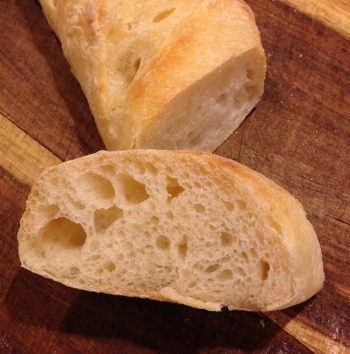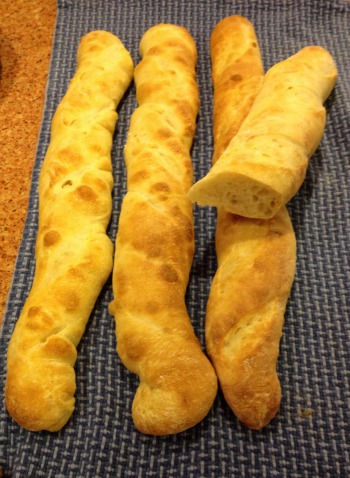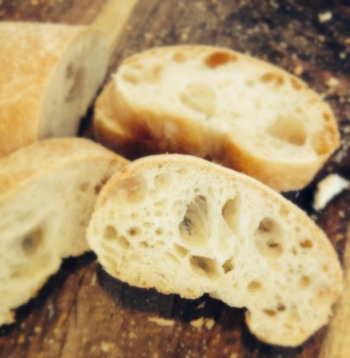I know, I know. This is "OT" when it comes to quilting. But a quilter's gotta eat, right? And if she's eating, she might as well be eating really, really good bread.
I believe I've mentioned before that I grew up as a child of the Back to Nature Movement. In 1970, my parents moved our family from the city out to a house in the country on seven acres--a house Dad built himself (well, more correctly, "was building" himself as it was little more than a frame when we first moved out there--but that's a story for another blog). Dad lived by the Farmer's Almanac and Mother Earth News. I often joke now that Dad would mow the lawn and we'd get it for dinner: Lamb's Quarters are something vegetarians could eat, if you didn't know. Put enough butter on it....
But more than the canned-just-about-anything, the homemade maple syrup, and definitely more than the homemade wine (a subject for that same other blog), what I appreciated about my growing-up-hippie years was Mom's homemade bread. Every Saturday, 15 loaves. The woman had serious biceps. Kneading, punching down, putting in the oven to rise*, then baking batch after batch well into the dinner hour...it was a weekend ritual. My favorite moments were Saturday nights, when Mom would let us slice into one loaf fresh out of the oven and have a big, thick hot slice slathered with butter (well, those were the margarine years) and strawberry jam (usually also homemade).
As an adult, I rarely had time to bake homemade bread . I did it once or twice, using Mom's techniques and recipe, and the kids loved it. To try to fill the need, I owned a bread machine a couple of different times--until, well, see the rather tragic blog post about the demise of my most recent one.
Now that the kids are grown and my schedule has seriously eased up, I felt the desire to start baking bread again. Enter Craftsy and Peter Reinhart and Artisan Bread Making.
Mom's method was great...but oh, the bread I've been baking! Peter's method is quite different, and produces a very different type of bread. I've been making baguettes, boules, and batards (O My). I plan on making a chocolate babka for an upcoming guild meeting. I'm putting the information about marbled ryes in my back pocket for future reference. Great stuff.
But even beyond the bread recipes which, arguably, you can find on the Internet or in any of Peter's books, there's Peter himself. He's an excellent teacher. His passion for bread-making comes through so clearly that he makes you want to jump up and run into the kitchen as soon as you're done watching a lesson. And his statement that bread is a metaphor of transformation imbues each loaf you shape with your hands with a depth of meaning beyond just, "Hey, this tastes pretty dang good."
And yet, it does taste pretty dang good.
So, the basics:
- 10 lessons in all, most 30-40 minutes (a couple are shorter, one is 47 mins).
- The first lesson talks about baker's math and gives a tremendous amount of background information that lays an excellent foundation for everything that follows, the second talks about supplies, definitions, and the 12 steps of bread making.
- In each lesson following, Peter gives very clear directions on how to measure and mix ingredients, shape, and rise the dough, bake the bread; as well as how to be ready to make adjustments based on your room temperature and relative humidity.
- The lessons go from straight lean dough, to country variations, rustic breads, enriched breads, marble rye, and that amazing chocolate babka that I'm going to make this weekend.
- The downloadable materials are excellent reference when you're actually in the kitchen and don't want to get flour or oil on your iPad. Ahem. (Don't ask how I know.)
I had to make a judgment call as to when I'd consider this class completed for the purpose of my tracking. If I had said to myself that I'd have to bake one of every type of bread he teaches before I call the class finished, I'd either be done in 2017 or I'd be the size of a house. I've now baked three batches of bread, using one method twice when the first results weren't what I'd hoped (second results turned out fantastic after I made a few adjustments as per his suggestions to take into account the cold snap we're now living in up in these parts). I'll be baking one more batch in the next couple of weeks--the aforementioned chocolate babka. I've watched all the lessons and made copious notes. Therefore, I've decided to call it done, knowing I'll keep going back and referencing this class for years to come.
I'm putting all the pictures into a gallery--just click on the picture to see the next photo in the gallery. If you're reading this by email, the gallery may not come through. If not, use this link to see it in Flickr.
Haven't tried out Craftsy yet? Use this link to find out more.
Want to check out Peter Reinhart's Artisan Bread Making class? Use this link!
(Full disclosure: Using those Craftsy links helps support this blog and podcast--thanks so much!)
*Backstory: Mom would put the huge batch of dough in a big plastic bucket in the oven to rise. We were all strictly warned never to turn on the oven without looking in it first. When I was somewhere around middle-school aged, one day my sister and I decided to bake a cake. "Flick," went the oven switch to bake, and "Swish" went the temperature control knob. About half an hour later, Mom came running up from the basement where she'd been in her quilt studio. "What's that I smell? What do I smell burning?" She raced into the kitchen and threw open the oven door, to reveal a mass of dough and melting plastic. I don't exactly remember what happened next. I don't, however, recall that my sister and I played any role in helping to clean up. My guess is that, in those moments, Mom didn't particularly want to even lay eyes on us so sending us to our rooms was likely the better option for her. Frankly, I'm surprised I lived to tell about it. To this day, I always open an oven door before I turn it on. Some lessons do stick.





